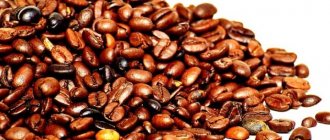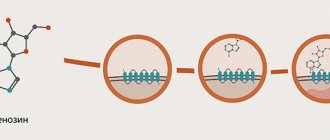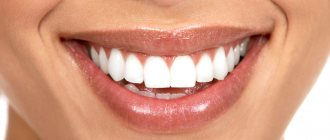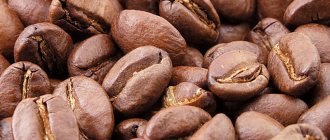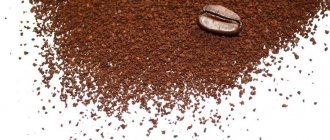A little history. How and by whom was caffeine discovered?
Friedrich Ferdinand Runge is a German chemist and brilliant scientist who was the first to identify caffeine.
He began his scientific experiments in his youth. But real fame and success came to him thanks to the writer Johann Goethe, a cat and coffee beans. It was Goethe who gave Runge a bag of rare coffee beans. 200 years have passed since then. Research into caffeine and its effects on the body continued. The result was the isolation of this component from tea in 1827 by M. Audry and its production artificially by G. E. Fisher in 1895. Fischer also became the first scientist to derive the structural formula of caffeine. It shows what caffeine consists of.
Symptoms of caffeine overdose
First you need to familiarize yourself with the list of contraindications to the use of this substance:
- state of arterial hypertension;
- the presence of cardiovascular pathologies of organic origin;
- manifestation of degenerative changes in the area of the optic nerve;
- the patient is in an overly excited state;
- regular insomnia;
- being in the gerontological age period.
If you ignore these rules and abuse the substance, the following symptoms of caffeine overdose may occur:
- difficulty falling asleep;
- stimulation of the central nervous system;
- excessive worry;
- addiction;
- increased blood pressure;
- increased heart rate;
- dizziness;
- stomach upset;
- seizures;
- attacks of suffocation;
- trembling of limbs;
- allergic reaction.
At the first symptoms of an overdose, it is necessary to help the victim
Products that enhance the effects of caffeine
Now let's move on to the question of how to neutralize caffeine in the body. First you need to familiarize yourself with the list of products that enhance its effect on the human body:
- Fried food. Consuming caffeine with these foods will put undue stress on your stomach.
- Alcoholic drinks. Drinking coffee or green tea together with liqueur and cognac can be bad for your heart and lead to the formation of tachycardia.
- Spicy dishes. Spices and seasonings are caffeine's #1 enemy. If taken together, indigestion or peptic ulcers may develop.
- Products containing caffeine. It is not recommended to drink coffee and tea together with chocolate, cola, or energy cocktails.
- Medicines. Headache medications also contain caffeine and have a stimulant effect. Therefore, you should refrain from drinking coffee during treatment.
Diagram - chemical composition of coffee beans
Green coffee beans are primarily composed of fiber, water, and coffee oils. The remaining 25% is caffeine, protein, mineral salts, the antioxidant chlorogenic acid (forms the astringent taste of coffee) and the alkaloid trigonelline (creates a unique aroma when roasted).
- More than 50% of green coffee is carbohydrates (sugars and fiber). They form the foam in espresso and make up the so-called body of the drink.
- Coffee contains many acids, and most of them are released during the heat treatment process. They have a positive effect on the functioning of the stomach and digestive system.
- Tannins create a bitter, slightly astringent taste. Dairy products (milk or cream) partially bind the tannins and make the drink taste less bitter.
- Caffeine invigorates, helps to concentrate, slightly increases blood pressure and activates the work of all body systems. Different varieties of coffee have different amounts of caffeine (Robusta has more than Arabica), and in addition, the place of growth and the method of processing the grain also matter.
Coffee always contains so-called coffee ash, which consists of potassium, magnesium, calcium, sodium and manganese.
Chemical formula and properties
Caffeine is an alkaloid found in some plants that affects the nervous system of humans and animals.
- The chemical name is 1,3,7-trimethylxanthine.
- The chemical formula of caffeine is C8H10N4O
Structural formula
As can be seen from the formulas, the components of caffeine are: carbon, hydrogen, nitrogen and oxygen. These elements are the basis of all organic compounds.
Physical properties of caffeine:
- It appears as white crystals.
- Has a bitter taste.
- Without smell.
- Solubility: good - in hot water (1:2), poor - in cold (1:60) and ethanol (1:50).
- Melting point – 234°C.
- Density – 1.23 g/cm³.
Content
- 1 Wikipedia
- 2 Wiktionary 2.1 Morphological and syntactic properties
- 2.2 Semantic properties 2.2.1 Meaning
- 2.2.2 Hypernyms
Caffeine
- an alkaloid (purine No. 7 - caffeine), found in plants such as the coffee tree, tea (the caffeine contained in or extracted from tea is sometimes called theine), mate (sometimes called mateine), guarana, cola, and some others. Also produced synthetically. Contained in various drinks, in small doses it has a stimulating effect on the nervous system. In large doses it causes exhaustion. In very large doses (average lethal dose is 10 grams) it causes death.
Table of changes in the chemical composition of coffee during roasting
Roasting coffee beans initiates many processes during which the composition of the coffee bean changes. The longer the roasting goes on, the greater the changes will be.
- Water. Water from the grains actively evaporates (from approximately 12% to 3%), and the content of other substances in terms of the changed mass increases.
- Sahara. During the roasting process they caramelize, which is what causes the brown color.
- Cellulose. Breaks down into acids, alcohols, amino acids.
- Fats. Partially decomposes into acids.
- Caffeine. Its amount remains almost unchanged, but since the grain loses moisture and the concentration of dry components increases, the relative content of caffeine in roasted coffee is higher than in green coffee.
- Chlorogenic acid. Its amount during frying is greatly reduced, but remains large enough to form an aroma and bitter taste.
- Trigonnelin. One of the most important alkaloids, during heat treatment it releases valuable vitamin PP, that is, nicotinic acid.
When roasting, the components of the grain not only break down into more compounds, but also react with each other, forming new (usually volatile) components. As a result, a special taste and aroma is formed.
Oily volatile compounds are quite fragile, and even in the absence of air their concentration decreases. Therefore, it is important to buy freshly roasted coffee and store it in small, covered containers.
How much caffeine is in different products
Coffee beans are the main and best known source of caffeine. It was in coffee that it was first discovered. Tea, carbonated drinks, sports nutrition, cocoa, chocolate - this is not a complete list of products that contain caffeine, in varying quantities. Accordingly, it is used by both adults and children.
With reasonable consumption, caffeine cannot harm even a child or a pregnant woman. For an adult, the daily norm is 300 mg, for pregnant women - 200 mg, and for a child 2.5 mg per 1 kg of weight. The calculation takes into account the volume obtained from all products consumed per day.
| Coffee (depending on the type and method of preparation) – 100 ml | 80-170 mg |
| Decaffeinated coffee – 100 ml | 2-3 mg |
| Black tea – 100 ml | 20-65 mg |
| Green tea – 100 ml | 15-30 mg |
| Instant cocoa – 100 ml | 2-3 mg |
| Natural cocoa – 100 ml | 5-10 mg |
| Dark chocolate – 100 g | 70-90 mg |
| Coca-Cola - 100 ml | 10.4 mg |
| Milk chocolate – 100 g | 10-60 mg |
| Instant coffee – 100 ml | 60-100 mg |
| Energy drinks – 100 ml | 20-35 mg |
| Painkillers - 1 tablet | 15-115 mg |
Negative effects on the body
Despite all the positive aspects, we should not forget that caffeine can be called a legal drug. It is a psychotropic substance that affects the central nervous system and is addictive when a certain dosage is exceeded.
For example, consuming 500-600 mg of caffeine per day can lead to insomnia, anxiety, irritability, upset stomach, increased heart rate, and even muscle tremors.
Whereas, when consuming 1000-1500 mg of caffeine, caffeine addiction may occur, which, in turn, can cause nervousness, irritability, restlessness, insomnia, headaches and rapid heartbeat, increased unconscious reflexes, and may increase the risk of bladder cancer.
Also, as incredible as it may sound, caffeine overdose is possible.
Its symptoms are abdominal pain, anxiety, mental and motor agitation, confusion, delirium (dissociative), dehydration, tachycardia, arrhythmia, hyperthermia, frequent urination, headache, increased tactile or pain sensitivity, tremors or muscle twitching; nausea and vomiting, sometimes with blood; ringing in the ears, epileptic seizures (in case of acute overdose - tonic-clonic seizures).
Advantages and disadvantages of instant coffee
In instant coffee, only 15-20% of the components are obtained from natural coffee. Espresso takes only 30 seconds to brew, while instant coffee beans are sometimes brewed for 5-10 hours. At the same time, all useful, aromatic and flavoring substances remain in the grounds, which are not used. Basically, only caffeine and some acids are transferred.
No manufacturer will make instant coffee from “100% highland Arabica,” as is sometimes written on the packaging. At most, broken and damaged grains will go there. And then, most often it is robusta, which has more caffeine.
The production of instant coffee involves boiling coffee beans, obtaining a coffee drink and then drying it. In this case, there is an intensive release of all the soluble elements contained in the coffee beans and their re-placement into the finished mass of soluble substance, which cannot but be accompanied by losses.
Instant coffee contains fewer nutrients than ground coffee
Manufacturers try to compensate for losses by adding these substances to the finished product, which inevitably leads to higher prices. Therefore, the cheaper the coffee on the counter, the poorer its taste and aroma. In addition, in the production of instant coffee, waste from the production of natural coffee is used, more often from discarded beans.
Perhaps the only advantage of instant coffee is the speed of preparation and the increase in its shelf life.
How does caffeine work?
It is a well-known fact that caffeine invigorates. But not everyone knows how he does it. By understanding how caffeine works, you can use it much more effectively. In simple terms, you can explain what caffeine does as follows.
During the day, while a person is busy with everyday activities, his body produces adenosine, the level of which is controlled by the central nervous system through receptors. Adenosine is a by-product of the breakdown of the ATP (adenositriophosphate) molecule. ATP, in turn, is the main source of energy in the body.
At the moment when adenosine levels rise to a critical level, fatigue occurs and the body gives a signal that it is time to rest. The molecule of caffeine and adenosine have a similar structure, so caffeine is able to enter adenosine receptors and block them, stimulating neurons. As a result, a person feels a surge of strength and vigor.
It is important to understand that caffeine does not have its own energy. By blocking receptors, it provokes the body to use additional ATP reserves. This risks the fact that it will take more time to restore strength, otherwise nervous exhaustion and chronic fatigue may occur.
Positive effect on the body
After the discovery of caffeine, coffee seemed to be reborn. Even then, in 1819, it began to be used as a medical drug.
Now there are about fifteen types of medications made on the basis of caffeine, which help restore the functioning of some internal organs.
The main effect of caffeine is to invigorate the body by stimulating the central nervous system, however, in addition, it successfully fights fatigue and improves concentration.
Caffeine also has a positive effect on brain function. A recent Harvard study found that drinking a couple cups of coffee daily reduced the risk of suicide in depressed people, while a more recent study found that drinking 200 mg of caffeine daily improved long-term memory. Other studies have suggested that its consumption reduces the risk of diseases such as type 2 diabetes, Parkinson's disease, cardiovascular disease and strokes.
Vitamins and minerals in the chemical composition of coffee
Natural coffee is rich in many vitamins and minerals that are beneficial to humans.
B3 is a vitamin obtained from trigonelline during heating. Positively affects the nervous system, normalizes metabolism.
A is a vitamin that affects the growth and development of all organs.
D – improves the absorption of nutrients in the intestines;
E – stimulates the immune system, has a positive effect on the reproductive system.
Potassium, magnesium and calcium are good for the heart, improve brain and vascular function, and strengthen the skeletal and muscular systems.
What substances are included in its composition?
Coffee is the favorite drink of millions of people. Among his most famous fans: Napoleon, Voltaire (he drank 50 cups a day and lived to be 84 years old), Honore de Balzac (if he couldn’t brew coffee, he simply chewed the beans), Beethoven (believed that good coffee only brewed from 60 beans), Victor Hugo (not only drank coffee, but also painted pictures with it). Peter I spread the fashion for coffee in Russia.
The chemical formula of coffee is very complex, since it contains a large number of different substances:
- proteins;
- fats;
- carbohydrates;
- caffeine;
- tannin;
- vitamins (B1, B2, E);
- trace elements (calcium, potassium, copper, iron, sodium);
- organic acids.
Depending on the variety and growing conditions, the concentration of certain substances in the grains will be different. The structure of raw and roasted coffee beans will also be different. This can be clearly seen in the table.
| Components | % content in coffee | |
| Raw grains | Roasted grains | |
| Water | 10,73 | 2,38 |
| Caffeine | 1,07 | 1,16 |
| Nitrogenous substances | 12,64 | 14,13 |
| Fat | 11,8 | 13,85 |
| Sugar | 7,62 | 1,31 |
| Cellulose | 24,01 | 18,07 |
| Dextrin | 0,86 | 1,31 |
| Tannins | 9,02 | 4,63 |
| Minerals | 3,02 | 4,65 |
| Other nitrogen-free substances | 20,3 | 39,88 |
Of all the listed substances, caffeine has the greatest effect on the human body. When the grains are roasted, the content of this alkaloid increases.
Caffeine content in various drinks
Caffeine is present in various products. In addition to coffee and tea, it is found, for example, in carbonated soft drinks, energy drinks, chocolate, candies, snacks, desserts and so on. The presence of caffeine depends on what the product was made from.
You can talk more specifically about the presence of caffeine in coffee.
You can find a lot of information on a wide variety of varieties, but, for example, the most common ones, such as Arabica, contain from 1000 to 1500 milligrams per hundred grams, the Robusta variety has from 1100 to 2500, and the Liberica variety has from 700 to 2500.
It is worth noting that the caffeine content in tea and coffee depends on the extraction (brewing) time of the drink. The longer, the more caffeine will be extracted.
If you are interested in finding out how much caffeine is contained in, for example, cappuccino or green tea, then you can see it in this table:
Coffee drinks
| DRINK | CAFFEINE CONTENT IN ONE CUP OF DRINK, MG | VOLUME |
| Espresso | 50-68 | 25-35 ml |
| Americano | 50-68 | 50-70 ml (espresso shot + 25-35 ml water) |
| Cappuccino | 50-68 | 140-180 ml (espresso shot + 30 ml milk + 30 ml milk froth) |
| Black coffee | 38-65 | Per 100 ml of drink (caffeine content will depend not only on the type of coffee, but also on the preparation method - in a Turk, French press, geyser coffee maker, etc.) |
| Instant coffee | 31-48 | Per 100 ml drink |
| Decaffeinated coffee | 3 | Decaf coffee is considered a product in which 97% of the caffeine (US) and 99% for the EU has been removed. |
Tea
| DRINK | CAFFEINE CONTENT IN ONE CUP OF DRINK, MG | VOLUME |
| Black tea | 40-50 | Per 100 ml drink |
| Green tea | 20-30 | Per 100 ml drink |
Decaffeination or how decaffeinated coffee is made
Coffee invigorates and, in reasonable doses, has a positive effect on the body of a healthy person. But people with cardiovascular diseases, pregnant women and children should avoid drinking this drink. What should those who love hot aromatic coffee do, but for one reason or another have contraindications?
Now many people know about the existence of decaffeinated coffee. But not everyone knows how this process happens. According to legend, the invention of decaffeination technology became possible thanks to chance. In 1903, the ship carrying coffee was caught in a storm and the cargo got wet. Ludwig Rosemus examined the beans and found that they were decaffeinated but still usable.
The main task of decaffeination is not only to make coffee safe for the body, but also to preserve its taste and aroma. Nowadays, technology has become so advanced that it is very difficult to distinguish between decaffeinated and decaffeinated coffee. There are several hundred ways of decaffeination. In any of them, green grain is processed. Three main methods are especially worth noting.
This method is the simplest and least expensive. The whole process looks like this:
- Green coffee beans are poured with hot water (but not boiling water) or treated with steam for 30 minutes.
- They are then immersed in solvents (methylene chloride or ethylene citate are most often used), which remove the alkaloid. This stage lasts on average 10 hours.
- After this, the grains are washed again in hot water to remove excess solvent.
- The final stage is drying.
The caffeine content with this method ranges from 1% to 3%. Among the disadvantages, it is worth noting the loss of taste and some useful substances due to the use of chemical solvents.
This method is newer and more expensive. It was introduced into use by the Swiss. The advantage of Swiss technology is that no chemicals are used in the process. Decaffeination stages:
- Green coffee beans are soaked in hot water.
- Next, the water is drained and caffeine is removed from it using a filter.
- After this, a new batch of grains is poured with water with flavor components dissolved in it. The result is a drink that is not inferior to natural coffee.
The use of carbon dioxide to decaffeinate beans was first proposed in Germany. This method was patented in 1970. The process consists of the following steps:
- First, the coffee beans are soaked in hot water.
- Next, they are placed for 10 hours in compressed carbon dioxide with a small amount of water (about 3%). The temperature should be 70 °C. Carbon dioxide will turn into liquid and act as a solvent.
- After the required time has passed, the grains are dried and roasted.
This technology allows you to preserve all the taste and aroma of coffee beans. And carbon dioxide leaves no traces behind. Accordingly, the resulting product is a healthy, aromatic drink.
Semantic properties
Meaning
- Chem. organic matter contained in coffee beans, tea leaves, kola nuts and some other plants; has a stimulating effect on the central nervous and cardiovascular systems; used in medicine as a stimulant, for drug poisoning, etc.? Coffee beans with reduced caffeine content.
Hypernyms
- Alkaloid
CAFFEINE (C8H10N4O2), a white, bitter-tasting ALKALOID found in coffee, tea and other substances such as cocoa plants and holly. In drinks it acts as a mild, harmless stimulant and DIURETIC, but in excessive doses it can cause insomnia and delirium.
A psychoactive stimulant with a bitter taste and no odor. Its effect manifests itself very quickly, within a few minutes after consumption. By influencing the central nervous system (brain and spinal cord), caffeine speeds up and intensifies breathing, heart contractions, speeds up metabolism, gives a feeling of vigor, relieves drowsiness and fatigue. It also has a diuretic effect and stimulates the constriction of blood vessels - this determines its ability to relieve headaches (if they were caused by dilation of the blood vessels of the head). Caffeine also increases muscle tone and improves coordination. In large doses, such as the amount found in four cups of coffee drunk over a short period of time, caffeine causes anxiety, insomnia, irritability and headaches.
People who regularly drink more than five cups of coffee a day become very addicted to caffeine. When they stop taking it, they may experience withdrawal symptoms: dizziness, irritability, headaches and weakness. Caffeine is eliminated from the body within a few hours, so its direct effects are short-lived. There is a theory, not yet proven, that long-term consumption of caffeine in high doses can cause high blood pressure, coronary heart disease and some birth defects in offspring.
Caffeine is found in many popular drinks. A cup of regular coffee contains about 100 mg of caffeine (compared to less than 5 mg in a cup of decaffeinated coffee); in a glass of tea or cola - about 50 mg; and a cup of cocoa contains about 10 mg.
Caffeine
, noun, number of synonyms: (8) 1. alkaloid 2. guaranine 3. caffeine 4. caffeine 5. medicine 6. methyltheobromine 7. theine 8. enzyme
Caffeine is an alkaloid with the formula C8H10N4O2; its chemical name is 1,3,7 - trimethylxanthine. In industry, it is obtained in three ways: by isolation from roasted coffee beans, which contain 0.75-1.5% caffeine; extraction from tea dust, i.e. ground tea leaves containing 1.5-3.5% caffeine; extracted from kola nuts containing about 2% caffeine. Additionally, it can be produced chemically from uric acid or by methylation of theobromine. Caffeine enhances the effects of aspirin and other analgesics and is often included in over-the-counter medications.
Green coffee beans are subject to decaffeination. There are several methods of decaffeination, but they all start the same way: the beans are soaked in water, organic solvents (ethyl acetate and methylene chloride are the most common), liquefied CO2, and other liquids until the pores open and the effect of the caffeine wears off. As a result of soaking, the coffee bean swells and doubles in volume. Very often, the decaffeination process is accompanied by a loss of taste and aromatic qualities. To prevent this from happening, the best way to carry out decaffeination is to soak the coffee beans in water while they are at the green bean stage.
After soaking in hot water, the liquid is drained and the grains are poured again. This time with a solvent. After the solvent, the beans are again filled with water, this time boiling (to remove all the solvent), thoroughly rinsed and dried. Thus, the process involves steaming the coffee, extracting it, removing the solvent and moisture. But no matter how well and no matter how the decaffeination process is carried out, a certain amount of solvent remains in the beans, which is unsafe for health.
Therefore, in 1979 (Swiss) proposed a new method of decaffeination - without the use of a solvent. Coffee beans are simply soaked in water. This removes caffeine from them. In principle, this method is a more advanced modification of the original version of decaffeination, discovered at the beginning of the 20th century (1903) by the German Ludwig Rosemus. This method is much more expensive, but safer and preserves the taste and aroma of the coffee beans. There are several other methods of decaffeination, including using compressed carbon dioxide (CO2) and decomposing caffeine through electrolysis. They do not leave any traces in the drink and allow you to preserve all its qualities.
Twin Peaks "Through the Fire"
— I don't use drugs. — Caffeine is a drug. Nicotine too. - What kind of smart guy is this?
House (Episode 5 "Crazy in Love")
Dr. House:
There are no coffee cups.
I decided to live without caffeine. Good for the child. Dr. Cuddy:
The cups are in another bucket, and the baby is in your imagination.
(No ratings yet)
Yuri Kulchitsky
Previous post
Pitching
Next entry




